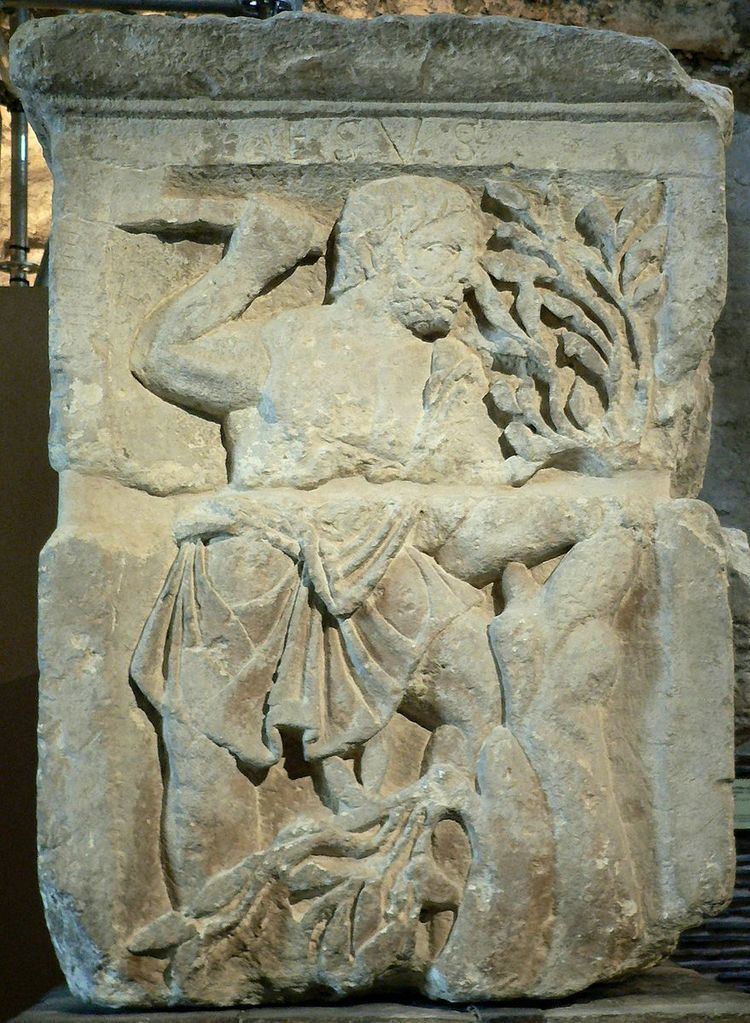 | ||
Esus, Hesus, or Aisus was a Gaulish god known from two monumental statues and a line in Lucan's Bellum civile.
Contents
Imagery
The two sculptures where Esus appears are the Pillar of the Boatmen from among the Parisii, on which Esus is identified by name, and a pillar from Trier among the Treveri with similar iconography. In both of these, Esus is portrayed cutting branches from trees with his axe. Esus is accompanied, on different panels of the Pillar of the Boatmen, by Tarvos Trigaranus (the ‘bull with three cranes’), Jupiter, Vulcan, and other gods.
Interpretations
John Arnott MacCulloch summarized the state of scholarly interpretations of Esus in 1911 as follows:
M. Reinach applies one formula to the subjects of these altars—"The Divine Woodman hews the Tree of the Bull with Three Cranes." The whole represents some myth unknown to us, but M. D'Arbois finds in it some allusion to events in the Cúchulainn saga. In the imagery, the bull and tree are perhaps both divine, and if the animal, like the images of the divine bull, is three-horned, then the three cranes (garanus, "crane") may be a rebus for three-horned (trikeras), or more probably three-headed (trikarenos). In this case, woodman, tree, and bull might all be representatives of a god of vegetation. In early ritual, human, animal, or arboreal representatives of the god were periodically destroyed to ensure fertility, but when the god became separated from these representatives, the destruction or slaying was regarded as a sacrifice to the god, and myths arose telling how he had once slain the animal. In this case, tree and bull, really identical, would be mythically regarded as destroyed by the god whom they had once represented. If Esus was a god of vegetation, once represented by a tree, this would explain why, as the scholiast on Lucan relates, human sacrifices to Esus were suspended from a tree. Esus was worshipped at Paris and at Trèves; a coin with the name Æsus was found in England; and personal names like Esugenos, "son of Esus," and Esunertus, "he who has the strength of Esus," occur in England, France, and Switzerland. Thus the cult of this god may have been comparatively widespread. But there is no evidence that he was a Celtic Jehovah or a member, with Teutates and Taranis, of a pan-Celtic triad, or that this triad, introduced by Gauls, was not accepted by the Druids. Had such a great triad existed, some instance of the occurrence of the three names on one inscription would certainly have been found. Lucan does not refer to the gods as a triad, nor as gods of all the Celts, or even of one tribe. He lays stress merely on the fact that they were worshipped with human sacrifice, and they were apparently more or less well-known local gods.
James McKillop cautions that Arbois de Jublainville's identification of Esus with Cú Chulainn "now seems ill-founded".
Jan de Vries finds grounds of comparison between Esus and Odin, both being patrons of sailors sometimes associated with Mercury to whom human victims were said to be sacrificed by hanging.
Miranda Green suggests that the willow-tree that Esus hews may symbolize "the Tree of Life [...] with its associations of destruction and death in winter and rebirth in the spring". She further suggests that the cranes might represent "the flight of the soul (perhaps the soul of the tree)".
In Neo-Druidism
The 18th century Druidic revivalist Iolo Morgannwg identified Esus with Jesus on the strength of the similarity of their names. He also linked them both with Hu Gadarn, writing:
Both Hu and HUON were no doubt originally identical with the HEUS of Lactantius, and the HESUS of Lucan, described as gods of the Gauls. The similarity of the last name to IESU [Welsh: Jesus] is obvious and striking.
This identification is still made in certain Neo-Druidic circles. Modern scholars consider the resemblance between the names Esus and Jesus to be coincidental.
